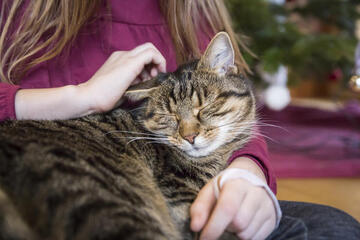Purinainstitute.ru | Главная
 Пол - это единственная физическая характеристика, имеющая отношение к выработке аллергенов
Пол - это единственная физическая характеристика, имеющая отношение к выработке аллергенов
Prevent clicks on page when mobile menu is being shown
Пол — это единственная физическая характеристика, имеющая отношение к выработке аллергенов


Наряду с тем, что исследования показали отсутствие взаимосвязи длины и цвета шерсти с выработкой Fel d1, одна физическая характеристика действительно имеет отношение к выработке этого белка - это пол кошки.
Факты
По результатам некоторых исследований, выработка белка Fel d1 зависит от пола кошки.
- Было показано, что некастрированные коты, как правило, продуцируют Fel d1 в большей степени, чем стерилизованные / кастрированные коты или кошки независимо от статуса стерилизации.1, 6-9
- Тем не менее, концентрация Fel d1 у каждой кошки варьируется в зависимости от наследственности, и некастрированный кот может продуцировать меньше Fel d1, чем высокопродуктивная кошка или кастрированный кот.1,6,8-11
Список литературы
- Kelly, S.M., Karsh, J., Marcelo, J., Boeckh, D., Stepner, N., Litt, D.,...Yang, W.H. (2018). Fel d1 and Fel d4 levels in cat fur, saliva and urine. Journal of Allergy and Clinical Immunology. doi: 10.1016/j.jaci.2018.07.033
- Bonnett, B., Messaoudi, K., Jacomet, F., Michaud, E. Fauquert, J.L., Caillaud, D., & Evrard, B. (2018). An update on molecular cat allergens: Fel d1 and what else? Chapter 1: Fel d1, the major cat allergen. Allergy, Asthma and Clinical Immunology, 14, 14. doi: 10.1186/s13223-018-0239-8
- Butt, A., Rashid, D. & Lockey, R. (2012). Do hypoallergenic cats and dogs exist? Annals of Allergy Asthma and Immunology, 108, 74-76.
- Nicholas, C., Wegienka, G. & Havstad, S. (2008). Influence of cat characteristics on Fel d 1 levels in homes. Annals of Allergy Asthma and Immunology, 101, 47-50
- Siebers, R., Healy, B., Holt, S., Peters, S., Crane, J. & Fitzharris, P. (2001). Fel d1 levels in domestic living rooms are not related to cat color or hair length. Journal of Allergy and Clinical Immunology, 108, 652-653. doi: 10.1067/mai.2001.118788
- Platts-Mills, T.A.E., Vervloet, D., Thomas, W.R., Aalberse, R.C. & Chapman, M.D. (1997). Indoor allergens and asthma: report of the Third International Workshop. Journal of Allergy and Clinical Immunology, 100, S2-S24. doi: 10.1016/S0091-6749(97)70292-6
- Zielonka, T., Charpin, D., Berbis, P., Luciani, P., Cassanova, D. & Vervloet, D. (1994). Effects of castration and testosterone on Fel d 1 production by sebaceous glands of male cats: I. Immunological assessment. Clinical and Experimental Allergy, 24, 1169-1173
- Ramadour, M., Birbnaum, J., Magalon, C., Lanteaume, A., Charpin, D. & Vervloet, D. (1998). Cat sex differences in major allergen production (Fel d1). Journal of Allergy and Clinical Immunology, 10, 282-284.
- Jalil-Colome, J., de Andrade, A.D., Birnbaum, J., Casanova, D., Mege, J.-L., Lanteaume, A., Charpin, D., & Vervloet, D. (1996). Sex difference in Fel d1 allergen production. Journal of Allergy and Clinical Immunology, 98(1), 165-168.
- Morgenstern, J.P., Griffith, I.J., Brauer, A.W., Rogers, B.L., Bond, J.F., Chapman, M.D. & Kuo, M.C. (1991). Amino acid sequence of Fel dI, the major allergen of the domestic cat: protein sequence analysis and cDNA cloning. Proceedings of the National Academy of Sciences, 88, 9690-9694.
- Bastien, B., Gardner, C. & Satyaraj, E. (2019). Influence of phenotype on salivary Fel d1 in domestic shorthair cats. Accepted, Journal of Feline Medicine and Surgery.
Youtube Video